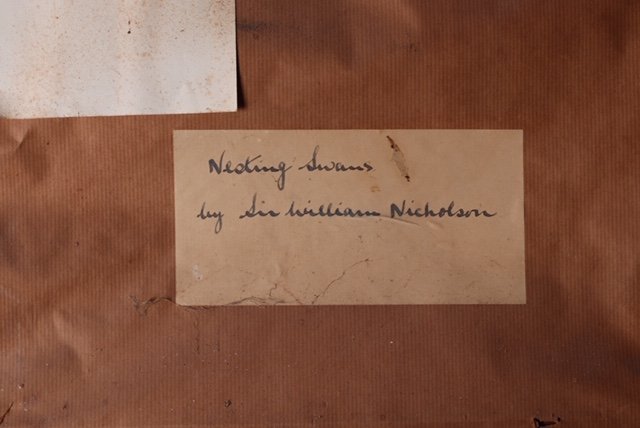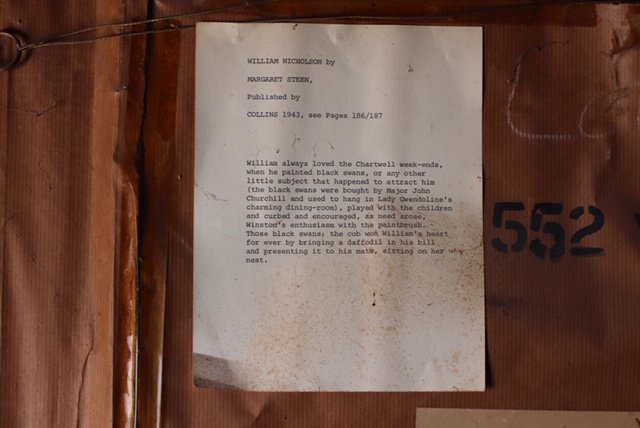SIR WILLIAM NICHOLSON
Nesting Swans, Chartwell
(Newark-on-Trent 1872 – 1949 Blewbury)
Oil on canvas-board - 12 ⅞ x 16 ⅛ inches (32.8 x 41 cm)
Signed ‘Nicholson’ (lower left)
PROVENANCE -
Major John Spencer-Churchill (1880-1947), from 1934; by 1941 at 10 Downing Street, London.
Clementine Churchill, later Baroness Spencer-Churchill of Chartwell, GBE, by 1956; her sale, Christie’s, London, 4 March 1977, lot 90 (purchased by Spink & Son on behalf of the present owner).
EXHIBITED -
London, Leicester Galleries, June 1934, no. 81, as ‘Nesting Swan’.
London, National Gallery, Paintings by Sir William Nicholson and Jack B. Yeats, January 1942, no. 44, as ‘Swans’.
London, Roland, Browse & Delbanco, William Nicholson Centenary Exhibition, 27 April-27 May 1972, no. 23 [32 acc CMW], and subsequently at the Aldeburgh Festival, 2-19 June, no. 87.
LITERATURE -
M. Steen, William Nicholson, London, 1943, p. 187.
L.Browse, William Nicholson, London, 1956, pp. 25 and 103, no. 442, pl. 34.
F. Davis in Country Life, 16 June 1977, p. 1650.
P. Reed, William Nicholson: Catalogue Raisonné of the Oil Paintings, London, 2011, p. 554, no. 719, illustrated.
Originally native to Australia, the first black swans at Chartwell, which was purchased by Winston and Clementine Churchill in 1922, were a gift from Sir Philip Sassoon. They were subsequently augmented by a pair sent by the Government of Western Australia. Churchill became devoted to them, claiming to be able to communicate with them in ‘swan-talk’.[i] Black swans are still kept at Chartwell, now looked after by the National Trust.
Nicholson and Churchill became friends after Nicholson was commissioned by friends of the Churchills to go to Chartwell to paint a portrait of them; executed in 1933, that is now sadly destroyed but the composition is known from a surviving study (see above). Churchill was out of political office in the 1930s and free to pursue other interests.
Nicholson subsequently made frequent visits to Chartwell in the years 1934-36, during which he taught Churchill to paint. Executed in the summer of 1934, this is one of three paintings by Nicholson of Winston’s black swans, which may be seen as particularly anticipating the pupil’s painting style.[ii] All are notable for their striking absence of a horizon line. Nicholson came to share Churchill’s fondness for the birds; according to his partner Marguerite Steen, ‘the cob won William’s heart for ever by bringing a daffodil in his bill and presenting it to his mate, sitting on her nest’.[iii] Nicholson also made drawings of Winston’s marmalade cat Utango and of his daughter Mary’s pug and dolls.
This is also one of two depictions of black swans which were to remain in the possession of Churchill’s immediate family until 1977. It became the property of Churchill’s brother Major John [‘Jack’] Spencer-Churchill either during or before Churchill’s exhibition at the Leicester Galleries, London, in June 1934. The inscription ‘JS Churchill’ in pencil on the reverse, in what appears to be Nicholson’s handwriting, suggests that it may have been a gift from the artist before the exhibition. Jack’s house was bombed in the Blitz and he moved into a flat at the top of 10 Downing Street, from which this painting was lent to the 1941 exhibition at the National Gallery. The other painting of Churchill’s black swans in the 1934 exhibition became at the same time the property of Winston’s wife Clementine and may well also have been a gift. The two paintings were reunited in Lady Churchill’s collection after Jack’s death in 1947 and remained together until sold by her in 1977, shortly before her death at the age of 92.
A pencil drawing of ‘A Swan at Chartwell’ sold from the collection of the late Sir John and Lady Witt at Sotheby’s, London, 19 February 1987, lot 373, is identified by Patricia Reed as a study for this painting.[iv]
Sold to the National Trust and returned to Chartwell.
[i] Churchill wrote to Clementine on 21 January 1935 ‘All the black swans are mating, not only the father and mother, but both brothers and sisters have paired off. The Ptolemys always did this and Cleopatra was the result. At any rate I have not thought it my duty to interfere’.
[ii] Patricia Reed, in her 2011 catalogue raisonné, mistakenly identifies this as the painting of black swans acquired from Spink & Son by Charles Wood, 2nd Earl of Halifax; the painting purchased by Lord Halifax from Spinks (in 1978) was the other Nicholson painting of black swans from the Churchill collection, Reed’s no. 721 on p. 555, illustrated in colour (William Nicholson painter: paintings, woodcuts, writings, photographs, ed. A. Nicholson, London, 1996, illustrated in colour p. 238). The third painting, in which the swans are larger and the composition less successful, was never exhibited by the artist; recorded as of 1936 when first exhibited in 1954, it is last recorded in the collection of Mrs Michael Sacher (Reed no. 720 on p. 555, illustrated in colour; exhibited London, Browse and Darby, William Nicholson 1872-1949, 1990, no. 31, illustrated in colour, on loan).
[iii] Steen, loc. cit.
[iv] Contrary to the information given by Reed, that was not illustrated in the auction catalogue.








